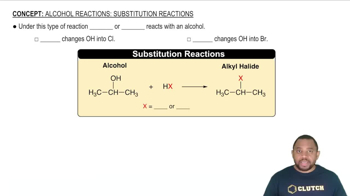Here are the essential concepts you must grasp in order to answer the question correctly.
Substitutional Alloys
Substitutional alloys are formed when atoms of one metal replace or substitute for atoms of another metal in the crystal lattice. This type of alloy typically retains the ductility of the parent metals, as the larger atoms can accommodate the smaller ones without significantly disrupting the overall structure. Common examples include brass, which is an alloy of copper and zinc.
Recommended video:
Alcohol Reactions: Substitution Reactions
Interstitial Alloys
Interstitial alloys are created when smaller atoms fit into the spaces (interstices) between the larger metal atoms in a crystal lattice. These alloys often exhibit increased hardness and strength but reduced ductility compared to substitutional alloys. An example is steel, where carbon atoms occupy interstitial sites in iron.
Ionic Radii and Alloy Formation
The ionic radii of elements play a crucial role in determining the type of alloy that can form. Substitutional alloys typically form between elements with similar ionic radii, allowing for effective substitution without significant lattice distortion. In contrast, interstitial alloys usually involve a significant size difference, where smaller atoms fit into the spaces of larger atoms.
Recommended video:



